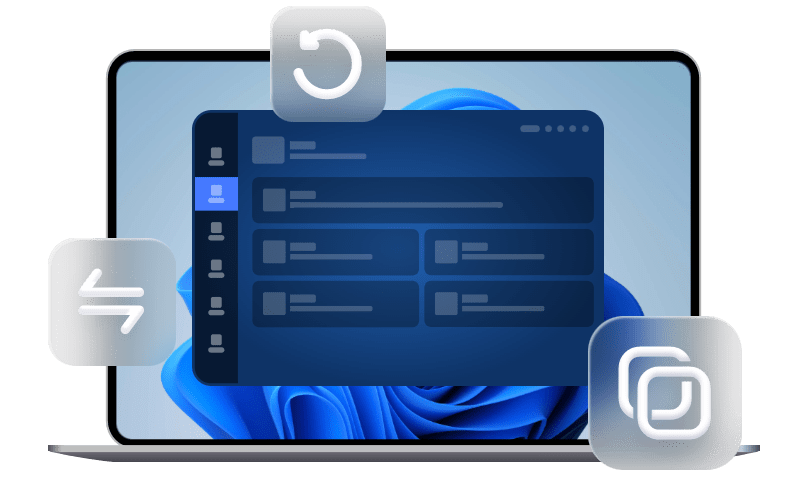What Are Windows Server Backup Limitations and Alternatives?
Do you use Windows Server Backup to perform backups in Windows Servers and find it fails sometimes? It’s time for you to learn Windows Server Backup limitations and get the best alternatives.
Although Windows Server Backup provides a basic backup solution for Windows Server users especially for small business owners, you may be disappointed by its limitations sometimes. Therefore, you’d better figure out Windows Server Backup limitations before you rely on it to protect the system and all your precious data.
Windows Server Backup crucial limitations you must know
Here I’m going to talk about several major limitations of WSB:
1. Windows Server Backup 2 TB limit
In Windows Server 2008 (R2), WSB backs up volumes to virtual hard disk (VHD) files, each VHD file for a volume in the backup. The VHD file has a 2 TB file size limit, so volumes larger than 2 TB cannot be backed up. However, in Windows Server 2012 and latter versions of Windows Server, Microsoft has introduced VHDX files that support storing Windows backup larger than 2 TB.
2. Windows Server Backup limit number of backups/copies
WSB owns the automatic disk space management feature. This feature deletes old backups automatically when it detects there is insufficient space for new backups. As a result, the number of backups kept by WSB is limited. Nevertheless, it will not shrink the storage space allocated for snapshots to less than 1/8 of target volume size, so you may find Windows Server Backup not deleting old backups sometimes.
3. Items to backup
You can only select entire volumes to backup, not individual files and folders. Furthermore, you can only select local volumes to backup, not network shares.
4. Destination drive
You can’t write backups to tape using WSB. Moreover, you will need a separate, dedicated disk for running scheduled backups, not just a partition.
5. Backup schedule
The Backup Schedule Wizard of WSB offers only two options: “Once a day” and “More than once a day”. If you want to perform Windows Server backup schedule weekly/monthly, you have to resort to Task Scheduler.
6. Monitoring and reporting
WSB offers neither the centralized monitoring ability for monitoring large numbers of servers nor the automated email reports about the backup status.
Now you know Windows Server 2016/2012 backup limitations. How to overcome the limitations of Windows Server Backup? What you need is powerful server backup software which is superior to WSB.
Best Windows Server Backup alternatives you need
1. AOMEI Backupper Server
AOMEI Backupper Server, specialized backup software for server, can be the best Windows Server Backup alternative. It is embedded with multiple features to meet all your demands concerning server backups:
♦ Full Backup Solutions
It offers 7 types of backup, including System/Disk/Partition/File Backup. You can create system image backup and backup specified disks/volumes as you wish.
♦ Up-to-date Backup Versions
You are allowed to run automatic backups in five schedule modes: Daily/Weekly/Monthly/Event triggers/USB plug in. Thus, you don’t need to worry about missing newly changed data.
♦ Versatile Backup Destinations
You are able to backup to internal/external hard drives, network share and NAS devices, etc.
♦ Smart Disk Space Management
It provides the Backup Scheme feature which will delete old backups automatically according to the retention number of backup versions you set.
♦ Wide Compatibility
It supports both Windows PC operating systems (Windows 11/10/8.1/8/7) and Windows Server operating systems (Windows Server 2025/2022/2019/2016/2012/2003, etc).
Wanna have a try? Just click the button below to download AOMEI Backupper Server 30-day free trial.
Best Windows Server backup and recovery software.
Now follow the steps below to schedule a system state backup and enable automatic disk space management via AOMEI Backupper:
Step 1. Install and launch AOMEI Backupper. Click on “Backup” and select “System Backup”.
Step 2. The required system partition(s) is (are) selected by default. Choose the destination path to store the backup files.
Step 3. Click “Schedule Backup” in the left bottom, and then choose “Enable Schedule Backup” to set the frequency of the system backup to run.
Step 4. In the Schedule window, click “Backup Scheme” from the left panel.
- Backup Method: you can choose to run full/incremental/differential backups.
- Enable Automatic Backup Cleanup: choose one cleanup rule from the drop-down menu. “By quantity”, “By time”, “By daily/weekly/monthly”, and “By space” are provided.
Step 5. Confirm the operations and click “Start Backup”.
Notes:
◑ To get email reports about the backup status, you can go to Options > General > Email notification.
◑ You are allowed to restore Windows Server Backup to another computer with dissimilar hardware in AOMEI Backupper.
2. AOMEI Cyber Backup
The best enterprise backup software - AOMEI Cyber Backup provides a convenient and reliable solution for centralized backup management of all Windows operating systems.
- It enables you to create system/disk/partition backup for a bunch of Windows PCs and Servers, supporting Windows 11/10/8.1/8/7 and Windows Server 2022/2019/2016/2012 (R2)/2008 (R2).
- You are allowed to save backup images on a local disk, external hard drive, network share or NAS device, etc.
- You can schedule a backup task to run daily/weekly/monthly using the full/incremental/differential backup method.
Download this powerful enterprise backup software now and follow the instructions below to backup Windows Server operating system.
Step 1. Install and run AOMEI Cyber Backup. The default username and password for AOMEI Cyber Backup are both "admin". Enter them and click Log in.
Step 2. Click Source Device > Windows > Add Windows Device to add the Windows Server device that you want to backup. You need to enter the IP address, username and password of it.
Step 3. Create a new backup task.
- Click Backup Task on the left menu bar and select Backup Task > Create New Task.
- In the Backup Type field, select System Backup.
- In the Task Name field, set your desired task name.
- In the Device Name field, click Select + to select the device you just added.
- In the Target field, click Select + and Add a new local storage or Add a new network storage to specify a destination path.
- In the Schedule field, change the backup method and schedule type as per your need.
- Click Start Backup > Add the schedule and start backup now to launch the backup process.
Learn more about Windows Server Backup
Windows Server Backup (WSB) is the built-in backup and recovery tool for Windows Server environments. It began with Windows Server 2008 as the replacement for NTBackup. You can use Windows Server Backup to back up a full server (all volumes), selected volumes, or the system state. Consisting of a Microsoft Management Console (MMC) snap-in and a command-line utility (wbadmin.exe), it enables you to use Windows Server Backup command lines to create backups easily.
Despite the limitations we mentioned above, Windows Server Backup also has some benefits that are worth considering.
-
Cost-Free: Windows Backup Server is free, with no charges for backup operations.
-
Reliable Source: It serves as a trustworthy solution for data storage and restoration.
-
Customizable Backups: You can easily select and exclude specific items from the backup process.
-
Automatic Updates: Your backup data will be automatically updated.
-
Secure Offline Solution: It provides a secure method for offline data restoration and backup.
-
Quick Restoration Options: Data restoration is fast and easy, with options for local drives or remote shared folders.
To sum up
Figuring out Windows Server Backup limitations can help you manage this tool better. If you are disappointed by all the limitations, you can use the best alternatives AOMEI Backupper Server or AOMEI Cyber Backup. They not only overcome the shortcomings of WSB but also offer you more advanced functions.
Actually, AOMEI Backupper is far more than a server backup tool. You can also use it to clone hard drive on Server 2016 and create Server 2019 bootable USB. Go for AOMEI Backupper right now!

